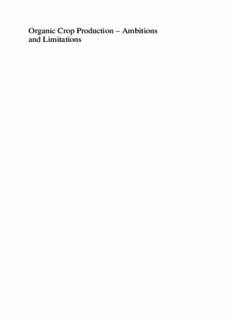Table Of ContentOrganic Crop Production – Ambitions
and Limitations
·
Holger Kirchmann Lars Bergstro¨m
Editors
Organic Crop Production –
Ambitions and Limitations
123
Editors
Dr.HolgerKirchmann Dr.LarsBergstro¨m
SwedishUniversity SwedishUniversity
ofAgriculturalSciences ofAgriculturalSciences
Dept.ofSoilandEnvironment Dept.ofSoilandEnvironment
P.O.Box7014 P.O.Box7014
SE-75007Uppsala SE-75007Uppsala
Sweden Sweden
ISBN978-1-4020-9315-9 e-ISBN978-1-4020-9316-6
DOI10.1007/978-1-4020-9316-6
LibraryofCongressControlNumber:2008938183
(cid:2)c SpringerScience+BusinessMediaB.V.2008
Nopartofthisworkmaybereproduced,storedinaretrievalsystem,ortransmitted
inanyformorbyanymeans,electronic,mechanical,photocopying,microfilming,recording
orotherwise,withoutwrittenpermissionfromthePublisher,withtheexception
ofanymaterialsuppliedspecificallyforthepurposeofbeingentered
andexecutedonacomputersystem,forexclusiveusebythepurchaserofthework.
Printedonacid-freepaper
9 8 7 6 5 4 3 2 1
springer.com
Preface
Organicagricultureisbeingpromotedagainstabackgroundofintensivediscussions
aboutproductionmethods,foodandfeedqualityandrenewableresources,withthe
overallaimoflong-termsustainability.Organicagricultureisasubjectthattriggers
manydifferentresponsesinpeople.Someareconvincedthatitisthewayforward,
whileothersquestionitsbenefitsandthewisdomofitslarge-scaleimplementation.
Even among the scientific community, different views have developed over recent
decades.
Organicagricultureispromotedinanumberofpopularandscientificbooksand
isoftendescribedasbeingsuperior,thesolutiontocommonagriculturalproblems
andameansofproducingbetterfood.Organicagricultureisoftenviewedasbeing
environmentallysoundandsuperiortoconventionalagriculturethroughtheexclu-
sion of synthetic fertilisers and pesticides. As a result, any questioning of organic
practices is unpopular and criticism is often interpreted as impeding the develop-
ment of sustainable systems. In addition, scientifically-based information contra-
dictingtheclaimsmadefororganicagriculturecanbedifficulttocommunicateand
canberegardedasastepbackwardsandagainstpoliticalmainstreamopinion.
The topic was discussed at a Symposium at the 18th World Congress of Soil
Science in Philadelphia in 2006, where benefits and problems relating to organic
cropproductionwerepresented.Someofthekeyfindingsfromthatsymposiumare
presentedinthisbook,togetherwithothercentralaspectsoforganiccropproduc-
tion.Theaimofthisbookistoprovidethereaderswithaclear,scientifically-based
overviewofanumberofrelevantsubjectsrelatingtoorganiccropproductionsothat
theycanformabalancedpictureofthisfoodproductionapproach.
Weareverythankfultoallthecontributingauthorsforprovidingtheirin-depth
viewsinthevariouschapters.Wewouldalsoliketoacknowledgealltheanonymous
reviewerswhohelpedtoimprovethequalityofthedifferentchaptersandDrMary
McAfee for excellent linguistic advice. Finally, we would like to thank Springer
forpublishingthebook,whichwehopewillprovideabetterunderstandingoftrue
long-termsustainabilityinfuturecropproduction.
Uppsala,Sweden HolgerKirchmann
July2008 LarsBergstro¨m
v
Contents
1 Widespread Opinions About Organic Agriculture – Are They
SupportedbyScientificEvidence? ............................... 1
LarsBergstro¨m,HolgerKirchmannandGudniThorvaldsson
2 FundamentalsofOrganicAgriculture–PastandPresent............ 13
Holger Kirchmann, Gudni Thorvaldsson, Lars Bergstro¨m, Martin
Gerzabek,OlofAndre´n,Lars-OlovErikssonandMikaelWinninge
3 CanOrganicCropProductionFeedtheWorld? ................... 39
HolgerKirchmann,LarsBergstro¨m,ThomasKa¨tterer,OlofAndre´n
andRuneAndersson
4 PlantNutrientsinOrganicFarming.............................. 73
KeithGoulding,ElizabethStockdaleandChristineWatson
5 NutrientSupplyinOrganicAgriculture–PlantAvailability,Sources
andRecycling.................................................. 89
HolgerKirchmann,ThomasKa¨ttererandLarsBergstro¨m
6 Synthesis of the Apelsvoll Cropping System Experiment in
Norway–NutrientBalances,UseEfficienciesandLeaching.........117
AudunKorsaethandRagnarEltun
7 Use Efficiency and Leaching of Nutrients in Organic and
ConventionalCroppingSystemsinSweden........................143
Lars Bergstro¨m, Holger Kirchmann, Helena Aronsson, Gunnar
TorstenssonandLennartMattsson
8 HowWillConversiontoOrganicCerealProductionAffectCarbon
StocksinSwedishAgriculturalSoils?.............................161
OlofAndre´n,ThomasKa¨ttererandHolgerKirchmann
vii
viii Contents
9 EnergyAnalysisofOrganicandConventional
AgriculturalSystems ...........................................173
Go¨teBertilsson,HolgerKirchmannandLarsBergstro¨m
10 TheRoleofArbuscularMycorrhizasinOrganicFarming ..........189
MeganH.RyanandMarkTibbett
11 OrganicFoodProductionandItsInfluenceonNaturallyOccurring
Toxins ........................................................231
CarlK.Winter
Index .............................................................241
Contributors
RuneAndersson DepartmentofFoodScience,SwedishUniversityofAgricultural
Sciences,P.O.Box7051,SE-75007Uppsala,Sweden
OlofAndre´n DepartmentofSoilandEnvironment,SwedishUniversityofAgricul-
turalSciences,P.O.Box7014,SE-75007Uppsala,Sweden,[email protected]
Helena Aronsson Department of Soil and Environment, Swedish University of
AgriculturalSciences,P.O.Box7014,SE-75007Uppsala,Sweden
Lars Bergstro¨m Department of Soil and Environment, Swedish University of
AgriculturalSciences,P.O.Box7014,SE-75007Uppsala,Sweden,
[email protected]
Go¨teBertilsson GreengardAB,P.O.Box552,SE-24495Do¨sjebro,Sweden,
[email protected]
Ragnar Eltun Bioforsk Arable Crops Division, Norwegian Institute for Agricul-
turalandEnvironmentalResearch,Apelsvoll,N-2849Kapp,Norway
Lars-Olov Eriksson Johannelunds Theological University College, Heidenstam-
storg75,SE-75427Uppsala,Sweden
MartinGerzabek InstituteofSoilResearch,UniversityofNaturalResourcesand
AppliedLifeSciences,Peter-Jordan-Straße82,A-1190Vienna,Austria
KeithGoulding Cross-InstituteProgrammeforSustainableSoilFunction,Rotham-
stedResearch,Harpenden,Hertfordshire,AL52JQ,UK,
[email protected]
Thomas Ka¨tterer Department of Soil and Environment, Swedish University of
AgriculturalSciences,P.O.Box7014,SE-75007Uppsala,Sweden
ix
x Contributors
Holger Kirchmann Department of Soil and Environment, Swedish University of
AgriculturalSciences,P.O.Box7014,SE-75007Uppsala,Sweden,
[email protected]
Audun Korsaeth Bioforsk Arable Crops Division, Norwegian Institute for Agri-
culturalandEnvironmentalResearch,Apelsvoll,N-2849Kapp,Norway,
[email protected]
Lennart Mattsson Department of Soil and Environment, Swedish University of
AgriculturalSciences,P.O.Box7014,SE-75007Uppsala,Sweden
Megan H. Ryan School of Plant Biology, University of Western Australia, 35
StirlingHwy,Crawley,WA,Australia,6009,[email protected]
Elizabeth Stockdale School of Agriculture Food and Rural Development, King
GeorgeVIBuilding,NewcastleUniversity,Newcastle-upon-Tyne,NE17RU,UK
MarkTibbett SchoolofEarthandGeographicalSciences,CentreforLandReha-
bilitation,UniversityofWesternAustralia,35StirlingHwy,Crawley,WA,Australia,
6009
Gudni Thorvaldsson Agricultural University of Iceland, Keldnaholti, IS-112
Reykjavik,Iceland
GunnarTorstensson DepartmentofSoilandEnvironment,SwedishUniversityof
AgriculturalSciences,P.O.Box7014,SE-75007Uppsala,Sweden
ChristineWatson SACAberdeen,FergusonBuilding,CraibstoneEstate,Aberdeen,
AB219YA,UK
Mikael Winninge Department of Religious Studies, Umea˚ University, SE-90187
Umea˚,Sweden
Carl K. Winter Department of Food Science and Technology, University of
CaliforniaDavis,CA95616,USA,[email protected]
Chapter1
Widespread Opinions About Organic Agriculture
– Are They Supported by Scientific Evidence?
LarsBergstro¨m,HolgerKirchmannandGudniThorvaldsson
Abstract Organic agriculture ostensibly offers a concept of sustainable practices
basedonenvironmentalresponsibility.Itiswidelybelievedthatorganicprinciples
basedonnaturalmeansandmethodsareenvironmentallysoundandthussuperiorto
systemsbasedonartificialinputs.Thisoverviewsummarisesthemainresultsonor-
ganicagricultureandhighlightsrelevantfactsinordertoprovidescientificinformation
aboutthepotentialandlimitationsoforganicagriculture.Thetopicsoffoodsecurity
andsafety,environmentalquality,systemsustainabilityandenergyconsumptionare
addressed.Someofthemainconclusionsarethatorganicagriculturehasconsistently
loweryieldsthanconventionalproductionandistherebyalessefficientmethodof
landuse;thatenvironmentalproblemscausedbyprocessessuchasnutrientleach-
ingarenotreducedbyconversiontoorganiccropproduction;andthatsoilfertility
statusandmicrobialbiodiversityarenotimprovedaprioribyorganiccropping.The
energyinvestmentforproductionofartificialNfertilisersresultsinafive-toten-fold
energyreturnintheformofbiomassandthishighlypositiveenergybalanceneeds
tobefullyacknowledged.Thefuturechallengeofdevelopingsustainableformsof
agriculturetoprovidesufficientfoodforagrowingworldpopulationwithminimal
environmentaldisturbancedeservesourwholeheartedandunbiasedattention.
Keywords Carbonsequestration·Energyissues·Foodproduction·Naturaltoxins·
Nutrientleaching·Pesticideresidues·Soilfertility
1.1 Introduction
Duringthepasttwodecades,organicagriculturehasoftenbeenpresentedasbeing
superiortoconventionalproductioninmanyrespects.Thishasledtoawidespread
belief among the general public that organic crop production is better and in an
ambitiontosatisfythisopinion,politiciansandlegislatorshavestronglypromoted
L.Bergstro¨m( )
B
DepartmentofSoilandEnvironment,SwedishUniversityofAgriculturalSciences,P.O.Box7014,
SE-75007Uppsala,Sweden
e-mail:[email protected]
H.Kirchmann,L.Bergstro¨m(eds.),OrganicCropProduction–Ambitions 1
andLimitations,DOI10.1007/978-1-4020-9316-6 1,
(cid:2)C SpringerScience+BusinessMediaB.V. 2008
2 L.Bergstro¨metal.
this type of agriculture. For example, in Sweden the political goal has been to in-
crease the area used for organic production to 20% of all arable soils. In addition,
organicallyproducedfoodshouldconstitute25%ofthefoodusedinstateschools,
hospitalsandresidentialhomesfortheelderly.Themaindrivingforceshavebeen
togeneratebenefitsfortheenvironmentandtoimprovefoodquality.Morerecently,
impacts on energy consumption, climate change and long-term sustainabilityhave
alsobeeninfocus.
Buying organically produced food, and thereby supporting all these benefits,
creates a feelgood factor for consumers of organically produced food. For many
people,organicallyproducedfoodisalwaysbetterevenifitrequireslong-distance
transport. However, the question is whether these common opinions circulating in
societyaresupportedbythescientificevidence.
Theprinciplesoforganicpracticesderivefromnaturalphilosophiesandnotnatu-
ralsciences.Adeeperscientifically-basedanalysisoflong-termorganicfieldexperi-
ments–whichisthemainfocusofthisbook–givesadifferentpictureofthebenefits
generated.However,scientificcomparisonsoforganicandconventionalfarmingare
unappealingtosocietysincetheyprovideevidencethatman-madeinventions,such
as artificial fertilisers, often lead to production of crops in larger quantities and of
goodquality.Thisisincontrasttothecommonbeliefthatweshouldalwaysfollow
rulesdeterminedbynature.
In this introductory chapter, we present some common opinions about organic
agriculture and discuss them briefly in the context of the results presented in the
otherchaptersofthisbook.Thefollowingtopicsrelatingtoorganicagricultureare
addressed:
(cid:2)
(cid:2) Foodsecurityandsafety
(cid:2) Environmentalquality
(cid:2) Systemsustainability
Energyconsumption.
1.2 WidespreadOpinionsVersusScientificEvidence
1.2.1 FoodIssues
Sincetheintroductionoforganicagricultureinthe1920s,foodqualityissueshave
beenaparticularfocus.Oneofthefoundersoforganicagriculture,RudolfSteiner
(1924), believed that artificial fertilisers would degenerate agricultural produce to
suchanextentthattheywouldnotbefitforhumanconsumptionbytheendofthe
20thcentury.Concernaboutlevelsofyieldonlyenteredtheagendamuchlater.
1.2.1.1 FoodSecurity
A general opinion in society is that conversion to organic crop production is fol-
lowed by little or no yield reduction and that organic crop production is therefore
Description:Many people believe that organic agriculture is a solution for various problems related to food production. Organic agriculture is supposed to produce healthier products, does not pollute the environment, improves the fertility of soils, saves fossil fuels and enables high biodiversity. This book ha

